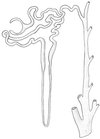S1) Introduction to the Urinary System Flashcards
(26 cards)
What is the mass of the kidneys?
Each weighs approx. 150g
Describe the location of the kidneys
Retroperitoneal:
- Left: T11 - L2
- Right: T12 - L3

Describe the relation of the ureter to the kidney
- Each kidney has single ureter
- Ureter is smooth muscle tube running from the renal pelvis to bladder

Identify and describe the 4 functions of the kidney
- Regulation: control the [substances] in ECF
- Excretion: waste products
- Endocrine: renin, erythropoietin, prostaglandins
- Metabolism: active form of Vitamin D, catabolism of insulin, PTH, calcitonin
Movement of water is driven by osmotic forces.
Define osmolarity and osmolality
- Osmolality: number of osmoles of solute per kilogram
- Osmolarity: number of osmoles of solute per litre
Define osmole
Osmole is a measure a solution’s ability to create osmotic pressure & thus affect movement of water
E.g. one mole of CaCl2 forms a 3 osmolar solution in 1L water
Relate osmolarity to osmosis in cells
Water moves from low osmolarity solutions to high:
- If ECF Osmolarity is high – water moves out of cells
- If ECF Osmolarity is low – water moves into cells

Intra- and extra cellular fluids have different electrolyte compositions. Differences are maintained by active transport.
Demonstrate this
- Intracellular: high K+, low Na+, many large organic anions
- Extracellular: low K+, high Na+, mainly Cl- and HCO3-
Kidneys affect extracellular fluid concentrations directly.
What happens when this system fails?
- Changes in BP
- Changes in tissue fluid and cell function
- Failure to control ECF osmolarity: cells shrink/swell
What is the functional unit of the kidney?
Nephron is a filter unit connected to a long tube for reabsorption

Describe the composition of a nephron
- A glomerulus: tuft of capillaries between afferent and efferent arteriole
- A tubule: Bowman’s capsule, proximal convoluted tubule, loop of Henle, distal convoluted tubule, collecting duct

Which parts of the nephron are found in the cortex of the kidney?
- Proximal convoluted tubule
- Distal convoluted tubule
Which parts of the nephron are found in the medulla of the kidney?
- Loop of Henle: dips into and out of medulla
- Collecting duct: passes through medulla to pelvis
What is epithelium?
Epithelia are continuous sheet of cells covering exposed surfaces and lining internal cavities e.g. digestive, reproductive, urinary and respiratory
What is the role of epithelia in the kidney?
- Excrete waste products from the body
- Reabsorb needed materials from the filtrate
The kidney is one of the most active organs in the body.
Briefly, describe its metabolic demands.
- Needs blood flow of 4 ml/g/min
- 22% of cardiac output at rest
Describe the structure and function of the glomerulus
- Structure: highly specialised filter
- Function: water, electrolytes and small molecules are forced through it by constant filtration pressure in capillaries

The proximal convoluted tubule is a major site for reabsorption.
Describe the processes occurring
- PCT absorbs 100% of glucose and amino acids
- Filtrate remains isotonic with plasma (water follows)
- Reabsorbed materials leave by peritubular capillaries

Describe the cellular mechanisms of reabsorption in the kidney
- Tubules are lined with polarised epithelial cells
- Different membrane properties on luminal and basolateral membranes

Outline the role of sodium pumps in the kidney
- Extrude Na+ across basolateral membrane
- Na+ enters across luminal membrane down concentration gradient
- Energy from sodium movement drives reabsorption of other substances e.g. glucose and H2O follows osmotically

The Loop of Henle is a further site of reabsorption of salts in the kidney.
Describe its general functions
- Create a gradient of increasing osmolarity in the medulla by counter-current multiplication
- Forms concentrated urine if water has to be conserved

Which processes occur in the distal convoluted tubule?
- Variable reabsorption of electrolytes and H2O
- Removes even more sodium and chloride and actively secretes H+ (fluid leaving loop of Henle is hypotonic)

What happens to water in the distal convoluted tubule?
Water may or may not follow reabsorption of electrolytes:
- Water is reabsorbed = concentrated urine (natriuresis)
- Water is not reabsorbed = dilute urine (diuresis)
Explain the role of the collecting duct in types of urine produced
The collecting duct passes through the high osmolarity environment of the medulla (created by the loop of Henle):
- If water can cross the epithelium = concentrated urine
- If water cannot cross = urine remains dilute


